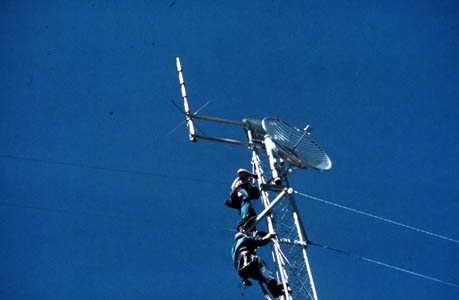
Enhanced Loran (eLoran) has survived through multiple generations of official ambivalence about the proposed backup for the U.S. Global Positioning System. Currently, the program is in (almost) on-again status.
The latest chapter began with President Obama’s Fiscal Year 2010 (FY10) budget proposal, which called for termination of Loran in the coming year. At a May 7 press conference, the president described Loran as a system that’s been eclipsed by the rise of GPS.
Enhanced Loran (eLoran) has survived through multiple generations of official ambivalence about the proposed backup for the U.S. Global Positioning System. Currently, the program is in (almost) on-again status.
The latest chapter began with President Obama’s Fiscal Year 2010 (FY10) budget proposal, which called for termination of Loran in the coming year. At a May 7 press conference, the president described Loran as a system that’s been eclipsed by the rise of GPS.
The president’s proposal had overruled plans set in motion last year for the Department of Homeland Security (DHS) to complete the upgrade to eLoran as a backup to GPS. This, in turn, was a change of course from a U.S. Coast Guard decision to terminate the program in 2008.
That Coast Guard stance had flown in the face of a $159 million program to upgrade existing Loran infrastructure to eLoran, funded by Congressional appropriations totaling during FY1997-2006. The upugrade is about 70 percent complete.
The activity comes on the heels of a Government Accountability Office (GAO) report warning about the possibility that the GPS constellation may decline substantially in the coming years.
You Say ‘Yes,’ I Say ‘No’
Now the U.S. Congress has inserted language into appropriation and authorization bills that would require continued operations of Loran-C, due to its potential utility as a national GPS backup. The issue is currently in the hands of a House-Senate appropriations conference committee.
The House version of the 2010 Homeland Security Appropriations Act, passed on June 24, funds the Loran-C system at $36 million and requires the Coast Guard to submit a plan for upgrading the system to eLoran, as a long-term backup for GPS.
“The immediate implementation of a long-term, robust backup system is vital, given the GAO’s recent finding that it is unclear whether new GPS satellites can be purchased and put in orbit in time to maintain uninterrupted GPS service to private and public sector consumers,” the House wrote in its report on the bill, H.R. 2892.
The Senate version (S. 1298), passed July 9, provides $18 million to extend Loran-C operations through January 4, 2010.
Loran-C operations shall not continue beyond that date only “if the Commandant of the Coast Guard certifies that: (1) the termination of the Loran-C signal will not adversely impact the safety of maritime navigation; and (2) the Loran-C system infrastructure is not needed as a back-up to GPS or any other Federal navigation requirement.”
On a separate track in the Senate, the Coast Guard Authorization Act for FY 2010 and 2011 (S. 1194), would authorize the Secretary of Transportation to maintain Loran-C and transition it to eLoran, providing $37 million per year in FY 2010 and FY 2011.
The bill, which passed the Senate Committee on Commerce, Science, and Transportation on July 8, would allow the U.S. Department of Transportation (DoT) to transfer funds from the Federal Aviation Administration (FAA) or other DoT agencies to reimburse the USCG for costs of the modernization.
The bill also requires a detailed 5-year plan for the eLoran transition.
Independent Review
The legislative initiatives implicitly confirm the findings of an Independent Assessment Team (IAT) on eLoran, funded by the office of the under secretary of transportation policy and chaired by Brad Parkinson, the first program manager for GPS.
DoT contracted with the Institute for Defense Analysis (IDA), which organized the IAT with IDA staff member Jim Doherty serving as the IAT’s executive director.
If offset by an estimated $146 million decommissioning cost of existing Loran infrastructure, the IAT concluded that eLoran could be established effectively for free.
Going forward, eLoran would require only the current $37 million per year in USCG operations and management base funds for Loran plus $20 million a year in new funds for five to eight years to complete all upgrades, new transmitters, and “jump start” deferred maintenance.
After that time, savings from substantially reduced staffing at the modernized facilities would offset eLoran operational and sustainment costs.
In December 2006 the IAT unanimously recommended that for, at least the next 20 years, eLoran “be completed and retained as the national backup system for critical safety of life, national and economic security, and quality of life applications currently reliant on position, time, and/or frequency from GPS.”
Among the IAT’s key findings: “eLoran is the only cost-effective backup for national needs; it is completely interoperable with and independent of GPS, with different propagation and failure mechanisms, plus significantly superior robustness to radio frequency interference and jamming.”
Despite the report’s acceptance by the Bush administration, which relied on it for the DHS decision to move forward with eLoran, a summary of the IAT findings and supporting charts was only released in May 2009. Parkinson told Inside GNSS that he estimates the probability of Congress approving eLoran at 75 to 80 percent.
Currently, the Radio Technical Commission for Maritime Services (RTCM) is developing performance standards for eLoran in the maritime environment.
eLoran also has strong support from the General Lighthouse Authorities (GLA) of the UK and Ireland (equivalent to USCG for maritime safety, which have committed to e-Navigation for maritime safety, using GPS/DGPS as primary input, eLoran as secondary or backup, and electronic charting.





